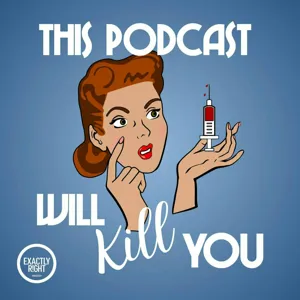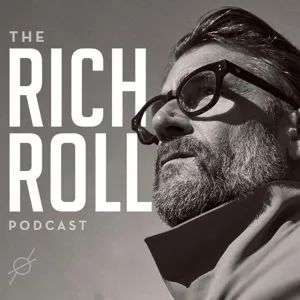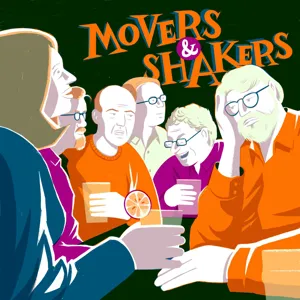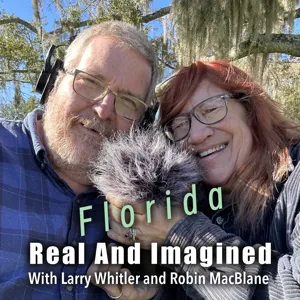Podcast Summary
Leonard's Journey with Encephalitis Lethargica: Leonard's story reveals the complexities of treating neurological conditions and the importance of understanding individual experiences, as demonstrated by his exceptional intelligence and resilience despite debilitating symptoms, and the impact of L-dopa on his energy levels and mental health.
The case study of Leonard L. from Oliver Sacks' "Awakenings" demonstrates the profound impact of encephalitis lethargica on individuals, leading to debilitating Parkinson's-like symptoms and isolation. Leonard's story highlights his exceptional intelligence and resilience despite his condition, which changed dramatically after being given L-dopa in 1969. Initially, the medication brought him a newfound sense of energy and ability to communicate, but it later led to excessive energy and psychosis, requiring its discontinuation. Leonard's experiences offer insights into the complexities of treating neurological conditions and the importance of understanding the individual's unique experiences. The movie "Awakenings," based on this case study, showcases Robert De Niro's powerful portrayal of Leonard and underscores the significance of this remarkable story.
Mystery of Encephalitis Lethargica: A Forgotten Sleeping Sickness: During the years 1917 to 1924, a mysterious sleeping sickness affected people worldwide, causing deep, unresponsive sleep and sometimes death. Known as encephalitis lethargica, it serves as a reminder of the importance of acknowledging and understanding obscure medical conditions.
During the years 1917 to 1924, a mysterious sleeping sickness affected people around the world, causing them to fall into deep, unresponsive sleep from which some never woke up. This condition, later known as encephalitis lethargica, was first observed in a 16-year-old girl named Ruth, who had been asleep for over a month and eventually died due to complications. The cause of this disease was unknown at the time, and it seemed to affect people with no common exposure or family links. Symptoms varied widely, from fever and headache to catatonic states and uncontrollable hiccups. The only thing these patients shared was their extreme sleepiness. This medical mystery, which occurred during the aftermath of World War I and the influenza pandemic, was largely forgotten over time. But it serves as a reminder of the importance of acknowledging and understanding even the most obscure medical conditions. So, while we may enjoy a soothing nightcap to help us relax and unwind, it's important to remember that sometimes, sleep can be a mystery that science has yet to unravel.
Mystery Disease Encephalitis Lethargica: A Sleep Disorder Linked to Influenza: Encephalitis lethargica, a sleep disorder that emerged around 1917, was linked to a major influenza epidemic in the late 1800s. Despite extensive research, its causes remained unknown and symptoms varied greatly from person to person.
The sleeping sickness known as Encephalitis lethargica, which emerged around 1917, was a mysterious disease that caused significant damage to the midsection of the brain, affecting sleep and leading to high mortality rates. Although its cause was unknown, researchers believed it was an infectious pathogen due to its observable symptoms in animals. This disease, also known as the "living dead" or "nonna," was linked to a major influenza epidemic in the late 1800s, and its manifestations varied greatly from person to person, with some experiencing hyperactivity and others extreme sleepiness. Despite extensive investigation, doctors were unable to fully explain the disease's causes or why it affected people differently. The epidemic began around a year before the 1918 influenza pandemic and persisted until the mid-1920s, with most cases occurring in those who had recently had the flu. The personal experiences and characteristics of patients seemed to play a role in their symptoms, as seen in cases of a child triggered by authoritative figures and a 129-year-old woman who woke after being serenaded by a violinist. The connection between Encephalitis lethargica and influenza remains a topic of ongoing research.
The encephalitis lethargica epidemic blurred the line between mind and brain: The epidemic caused neurological symptoms and psychological changes, leaving long-term effects that were unpredictable and often debilitating, highlighting the complex relationship between the mind and brain.
The encephalitis lethargica epidemic in New York City during the early 20th century was a deeply personal and confusing disease that blurred the line between the mind and the brain. Neuropsychiatrists, who treated both nerves and mental disorders, worked closely with public health officials to identify and track the outbreak, which infected over 5,000 New Yorkers and resulted in a high mortality rate of 40-50%. The disease presented various neurological symptoms, including extreme forms of Parkinson's disease in adults and psychological changes, such as extreme behavioral changes and loss of impulse control, in children. The disease was particularly devastating for children, causing brain swelling that damaged the frontal lobe and resulting in negative changes, including homicidal or suicidal tendencies, complete lack of morality, and extreme impulsivity. The disease's long-term effects were unpredictable and often debilitating, leaving many people feeling like they had lost control of their minds and bodies. This is similar to conditions like locked-in syndrome, where the mind is intact but the body and brain are not under one's control. The epidemic highlighted the complex relationship between the mind and the brain and the need for a better understanding of neurological disorders.
Mysterious Disease Encephalitis Lethargica: A mysterious disease, Encephalitis Lethargica, left thousands with debilitating symptoms during the 1910s and 1920s. Despite efforts to understand and develop a vaccine, the cause remained unknown, and funding was eventually cut. The disease, once a major focus in neurology, was eventually forgotten.
During the 1910s and 1920s, a mysterious disease known as encephalitis lethargica left thousands of people around the world with debilitating symptoms, including apathy, dissociation, and the loss of ability to care for themselves. The cause of the disease was unknown, and despite the efforts of the Matheson Commission, which aimed to understand and develop a vaccine for it, the disease faded from memory as the number of acute cases declined. The commission, led by neurologist and bacteriologist Josephine Neal, faced opposition from her male colleagues but was supported by Matheson. The commission's initial goal was to determine the extent of the disease and its patterns, which required international collaboration. The leading hypotheses for the causative agent were a streptococcus bacterium or a herpes virus, but no definitive answer was found before funding for the commission was cut short with the death of Matheson. The disease, once a major focus in neurology, was eventually forgotten and stopped being taught in medical schools by the 1960s. This is a brief overview of the history of encephalitis lethargica, a disease that left a lasting impact on medical history.
Lethargic Encephalitis: A Historical Health Crisis: Encephalitis lethargica, a form of brain inflammation causing lethargy, confusion, and forgetfulness, was a major health crisis in the early 1900s, affecting many and leaving some to die or be institutionalized. Its three main forms included somnolent, akinetic, and hyperkinetic.
Encephalitis lethargica, also known as "lazy brain inflammation," is a form of brain inflammation characterized by lethargy, confusion, and forgetfulness. It was a major health crisis in the early 1900s, affecting a large portion of the population and leaving many to die slowly or be institutionalized. Encephalitis, meaning inflammation of the brain, can be caused by various agents including viruses, bacteria, and autoimmune diseases. Encephalitis lethargica had three main clinical varieties: the somnolent form, characterized by a prodrome period and deep, uninterrupted sleep; the amyostatic akinetic form, marked by muscle rigidity and lack of response; and the hyperkinetic form, which presented with excessive motor activity. The somnolent form was the most common and was often fatal, with about 50% of patients dying.
Historic Disease Encephalitis Lethargica: Two Forms of Sleep Disturbances: Encephalitis Lethargica causes sleep disturbances in two forms: hypersonnolence and hyperkinetic, with the latter leading to the discovery of sleep's importance for proper function, and varying mortality rates and eye muscle issues between forms.
Encephalitis lethargica, an historic disease, can cause significant sleep disturbances in two main forms: hypersonnolence and hyperkinetic. In the hypersonnolent form, individuals experience extreme sleepiness and may eventually fall into a deep, deep sleep. In contrast, the hyperkinetic form is characterized by insomnia, anxiety, muscle twitching, and severe muscle pain. The same part of the brain is believed to be affected, leading to these opposing symptoms. The hyperkinetic form also led scientists to realize the importance of sleep for proper function. Mortality rates varied between forms and progression, with the early phase of hyperkinetic having a higher mortality rate than 50%, but later progression to somnolent resulting in a lower mortality rate. Eye muscle problems were more common in the hyperkinetic form, leading to paralysis or eye position issues. The least common form, amyostatic kinetic, presented with muscle weakness and rigidity, along with early Parkinson-like symptoms without the characteristic tremor.
Encephalitis Lethargica: A Disease Affecting the Brain and Nerves: Encephalitis Lethargica caused neurological symptoms including sleep disorders and ocular problems due to inflammation in the brain. Postencephalitic Parkinsonism, a condition that developed in many survivors, was characterized by muscle rigidity, delayed movement, and a lack of energy and motivation.
Encephalitis lethargica, an infectious disease that affected thousands in the 1920s and 1930s, led to various neurological symptoms including sleep disorders and ocular problems due to inflammation in the brain. The ocular nerves, specifically those controlling eye movement, were often affected due to their proximity to the inflamed areas. Three main forms of encephalitis lethargica were identified: acute, subacute, and residual. Postencephalitic Parkinsonism, a condition that developed in many survivors, was characterized by muscle rigidity, delayed movement, and a lack of energy and motivation. This condition was described as individuals being conscious but not fully awake, lacking emotion, and having a passive and insubstantial presence. This is a more extreme version of Parkinson's disease, which also includes symptoms such as flattened affect and cogwheel rigidity.
Encephalitis Lethargica: Different Causes, Similar Symptoms: Encephalitis Lethargica causes brain damage resulting in symptoms similar to Parkinson's disease, but the underlying causes and protein accumulation differ.
The brain damage caused by encephalitis lethargica, an epidemic that occurred in the early 1900s, leads to symptoms similar to Parkinson's disease, but the underlying causes are different. The damage includes congestion of blood vessels, small hemorrhages, and inflammation, particularly in the brain stem, which controls movement. However, the protein accumulation seen in patients with encephalitis lethargica is not the same as in Parkinson's disease. Instead, it resembles Alzheimer's disease, but in the wrong part of the brain. This difference in location is what sets encephalitis lethargica apart from Parkinson's disease, despite their similar symptoms. Despite the differences, some treatments for Parkinson's disease have been found to be effective for those with postencephalitic Parkinsonism. However, interest in treating this condition had largely stopped by the time Oliver Sacks arrived at Mount Carmel, an institution for those with nervous system injuries and postencephalitic symptoms, in 1966. At this point, supportive care was the primary treatment approach, with a stable and nurturing environment being crucial for improving quality of life.
Finding hope in the most dire circumstances: Despite apparent catatonia, patients with postencephalitis could be awakened with levodopa, restoring their ability to move, communicate, and engage with the world. Sacks' belief in their potential led to remarkable transformations, bringing hope to their lives and loved ones.
Even in the most dire circumstances, there is always hope for human connection and improvement. Oliver Sacks' work at Mount Carmel Hospital revealed that patients with postencephalitis, long believed to be past the point of hope, could be awakened with the use of levodopa. These patients, who had been forgotten and left to watch the world pass them by, were able to regain their ability to move, communicate, and engage with the world once again. Sacks' determination to see past their apparent catatonia and believe in their potential led to remarkable transformations. The discovery of levodopa's effect on these patients not only brought hope to their lives but also to their families and loved ones. The story of these patients serves as a reminder of the importance of never giving up on those who seem lost and the potential for human connection and growth, even in the most challenging circumstances.
Understanding the complexities of treating neurological disorders with L-dopa: L-dopa brought miraculous awakenings but also unpredictable responses, requiring delicate balance. Focus on individual experiences and ongoing research is crucial when introducing new treatments for neurological disorders.
Learning from Oliver Sacks' "Awakenings" is the complex and unpredictable nature of treating neurological disorders with drugs like L-dopa. While the drug brought miraculous awakenings for some patients with postencephalitic syndrome, it also led to sensitivity and unpredictable responses, requiring a delicate balance. Sacks' decision to focus on case histories instead of statistics highlighted the importance of understanding individual experiences and the limitations of reducing people to numbers. The discovery of the risks of overstimulation in patients with brain damage also applied to other neurological conditions like Parkinson's disease, where L-dopa-induced symptoms were often mistaken for the disease itself. Overall, Sacks' work underscores the importance of careful consideration and ongoing research when introducing new treatments for neurological disorders.
Disease affects individuals uniquely and deeply: While we can make generalizations and advance in medical knowledge, the personal nature of disease and its complex causes and effects cannot be fully understood
Disease affects individuals uniquely, and our understanding of it is still evolving. Encephalitis lethargica serves as a reminder of this, as it resulted in various responses and experiences for those affected. While we can make generalizations and advance in medical knowledge, the personal nature of disease and the complexities of its causes and effects cannot be fully captured. As Oliver Sacks noted, those who experienced the condition were forever changed, and their experiences deepened both them and those who shared in their journeys. Despite our advancements, much about encephalitis lethargica and its connection to postencephalitic Parkinsonism remains unclear. It's a reminder that there is still much to learn about disease and the human experience.
The link between influenza and encephalitis lethargica is not definitively established: Historical cases suggest a connection between influenza and encephalitis lethargica, but there's no conclusive evidence to support this theory. Further research is needed to understand the cause and potential prevention methods for this rare condition.
The connection between influenza and encephalitis lethargica, a condition causing severe fatigue, sleep disturbances, and motor symptoms, is not definitively established despite some historical cases suggesting a link. The cause of encephalitis lethargica remains a mystery, with the most popular theories being an infectious disease or an autoimmune disorder. While influenza was once considered a leading suspect due to temporal associations between influenza outbreaks and encephalitis lethargica epidemics, there is currently no conclusive evidence to support this theory. The condition has been rare since the 1940s, with only a handful of cases reported compared to the millions of cases during the epidemic between 1916 and 1925. Further research is needed to understand the cause and potential prevention methods for encephalitis lethargica.
The cause of the 1918 encephalitis lethargica outbreak is still a mystery: Despite ongoing research, the cause of the 1918 encephalitis lethargica outbreak remains unclear, with theories suggesting bacterial infection, enterovirus, or autoimmune response as possible explanations
The cause of the 1918 encephalitis lethargica outbreak is still a mystery, and it's possible that it was not caused by the influenza virus directly, but by a secondary bacterial infection or an enterovirus. Another theory suggests that it might be autoimmune in nature, triggered by an infection with a streptococcus bacteria. Researchers have found evidence of high antibody levels against streptococcus infections in patients with encephalitis lethargica, indicating a recent strep infection and potential autoimmune response. However, the sample size of this study was small, and more research is needed to confirm these findings. The cause of the 1918 epidemic remains an intriguing medical mystery, and further investigation is necessary to understand the underlying mechanisms and potential preventative measures.
The cause of encephalitis lethargica, or sleeping sickness, remains a mystery: Despite extensive research, the cause of encephalitis lethargica is still unknown, with theories suggesting links to strep infections and autoimmune responses, but recent evidence being inconclusive. Some cases involve anti-NMDA receptor antibodies, but not all do, making a definitive cause elusive.
Despite extensive research, the cause of encephalitis lethargica, also known as sleeping sickness, remains a mystery. Early studies suggested a link to strep infections and an autoimmune response, but more recent evidence has been inconclusive. A newer form of autoimmune encephalitis, NMDA receptor encephalitis, has been identified, and some cases of encephalitis lethargica have been found to involve anti-NMDA receptor antibodies. However, not all patients with encephalitis lethargica have these antibodies, making it difficult to establish a definitive cause. Additionally, the definition of encephalitis lethargica has evolved over time, making it challenging to diagnose and distinguish from related conditions. Recent cases tend to be in children rather than adults, adding to the confusion. In summary, while there have been many theories and some intriguing findings, the cause of encephalitis lethargica remains elusive.
Mystery of Encephalitis Lethargica: A forgotten epidemic that expanded our knowledge of the brain: The mysterious Encephalitis Lethargica epidemic left survivors with neurological symptoms, expanding our knowledge of the brain and similar conditions like Parkinson's disease. Despite its unknown cause and uncertain recurrence, it continues to inspire medical research.
Encephalitis Lethargica, a mysterious epidemic that occurred in the early 1900s, left survivors with various neurological symptoms including hypersomnolence, wakeability issues, ophthalmoplegia, and psychiatric changes. These symptoms led researchers to classify these cases as a form of encephalitis lethargica. However, only about 14 out of the 200 documented cases fit this criteria. The cause of the epidemic remains unknown, and it's unclear if it will reoccur. Despite being largely forgotten, the study of Encephalitis Lethargica has expanded our knowledge of the brain and the possible causes of similar symptoms, such as those seen in Parkinson's disease. The lack of information about the epidemic is a reminder of the importance of documenting and studying medical mysteries. The works of Oliver Sacks and Molly Caldwell Crosby have kept the memory of Encephalitis Lethargica alive, and it continues to inspire medical research. The symptoms of Encephalitis Lethargica and their similarities to Parkinson's disease highlight the intricacies of the mind and brain. The study of these cases has led to many insights and discoveries in the field of neurology.





